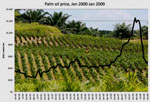Update: Did Malaysia cancel plans for palm oil development in the Amazon?
Malaysia’s Land Development Authority FELDA will soon break ground on a joint venture with a Brazilian firm to establish 30,000-100,000 hectares (75,000 – 250,000 acres) of oil palm plantations in the heart of the Amazon rainforest, reports the Malaysian Star.
Brazil’s Ambassador to Malaysia, Sergio Arruda, said the venture will start with 30,000 hectares cultivated near Tefe and Manuas. He said the land will be cultivated by 500 families.
FELDA has a 70 percent stake in the venture, called Felda Global Ventures Brazil Sdn Bhd, while Braspalma of Brazil holds the balance.
The project would include the establishment of a production plant which would lead to the development of a “state-of-the-art” palm oil biodiesel facility.
The venture could be the first of many oil palm projects in the Brazilian Amazon. Congress is weighing a law that would allow landowners to count plantations as forest towards their legal forest reserve requirement. By law landowners in the legal Amazon must retain 80 percent forest cover on their holdings.
A recent study estimated that 2.3 million square kilometers of the Brazilian Amazon are suitable for growing oil palm.
RELATED
Is oil palm the next emerging threat to the Amazon
(03/23/2009)
The Amazon Basin appears poised to experience rapid expansion of oil palm agriculture. Nearly half of Amazonia is suitable for oil palm cultivation, and Malaysian corporations are now moving into the region to establish new plantations while the Brazilian government is considering a law that would count oil palm as “forest” towards a landowner’s forest reserve requirement. Strong economic incentives for a major Amazonian oil palm industry are likely, given growing global demands for edible oils, oil-based products, and biofuel feedstocks. We have two main concerns. First, oil palm plantations are ecologically depauperate, supporting little forest-dependent wildlife. Second, we disbelieve political and corporate statements suggesting that oil palm plantations will be concentrated on previously deforested lands in Amazonia. In reality, oil palm producers strongly favor clearing primary forest for plantations because they can reap immediate profits from timber production. These profits subsidize the costs of plantation establishment and maintenance for the initial 3-5 years until the oil palm plantations become profitable. Hence, oil palm agriculture could soon emerge as a major new threat to the Amazonian environment.

Will palm oil drive deforestation in the Amazon?
(03/23/2009)
Already a significant driver of tropical forest conversion across southeast Asia, oil palm expansion could emerge as threat to the Amazon rainforest due to a proposed change in Brazil’s forest law, new infrastructure, and the influence of foreign companies in the region, according to researchers writing in the open-access journal Tropical Conservation Science. William F. Laurance, a senior scientist at the Smithsonian Tropical Research Institute (STRI) in Panama City, Panama, and Rhett A. Butler, founder of environmental science web site Mongabay.com, warn that oil palm expansion in the Brazilian Amazon is likely to occur at the expense of natural forest as a result of a proposed revision to the forest code which requires land owners to retain 80 percent forest on lands in the Amazon. The new law would allow up to 30 percent of this reserve to consist of oil palm.














